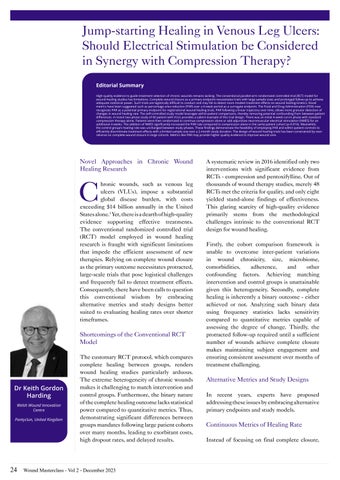Jump-starting Healing in Venous Leg Ulcers: Should Electrical Stimulation be Considered in Synergy with Compression Therapy? Editorial Summary High-quality evidence to guide treatment selection of chronic wounds remains lacking. The conventional parallel-arm randomized controlled trial (RCT) model for wound healing studies has limitations. Complete wound closure as a primary endpoint necessitates trials with large sample sizes and prolonged follow-up to achieve adequate statistical power. Such trials are logistically difficult to conduct and may fail to detect more modest treatment effects on wound healing kinetics. Novel metrics have been suggested such as percentage area reduction (PAR) over a 4-week period as a surrogate endpoint. The Food and Drug Administration (FDA) now recognizes PAR as a potential primary endpoint for registrational wound healing trials. PAR following a linear trajectory over time, allows more granular detection of changes in wound healing rate. The self-controlled study model leverages within-patient comparisons, thereby removing potential confounding from between-patient differences. A recent two-phase study of 60 patient with VLUs provides a salient example of this trial design. There was an initial 4-week run-in phase with standard compression therapy alone. Patients were then randomized to continue compression alone or add adjunctive neuromuscular electrical stimulation (NMES) for an additional 4 weeks. The addition of NMES significantly increased the PAR rate compared to compression alone in the same patient cohort (p=0.016). Meanwhile, the control group’s healing rate was unchanged between study phases. These findings demonstrate the feasibility of employing PAR and within-patient controls to efficiently discriminate treatment effects with a limited sample size over a 2-month study duration. The design of wound healing trials has been constrained by overreliance on complete wound closure in large cohorts. Metrics like PAR may provide higher quality evidence to improve wound care.
Novel Approaches in Chronic Wound Healing Research
C
hronic wounds, such as venous leg ulcers (VLUs), impose a substantial global disease burden, with costs exceeding $14 billion annually in the United States alone.1 Yet, there is a dearth of high-quality evidence supporting effective treatments. The conventional randomized controlled trial (RCT) model employed in wound healing research is fraught with significant limitations that impede the efficient assessment of new therapies. Relying on complete wound closure as the primary outcome necessitates protracted, large-scale trials that pose logistical challenges and frequently fail to detect treatment effects. Consequently, there have been calls to question this conventional wisdom by embracing alternative metrics and study designs better suited to evaluating healing rates over shorter timeframes.
Shortcomings of the Conventional RCT Model
Dr Keith Gordon Harding Welsh Wound Innovation Centre Pontyclun, United Kingdom
24
The customary RCT protocol, which compares complete healing between groups, renders wound healing studies particularly arduous. The extreme heterogeneity of chronic wounds makes it challenging to match intervention and control groups. Furthermore, the binary nature of the complete healing outcome lacks statistical power compared to quantitative metrics. Thus, demonstrating significant differences between groups mandates following large patient cohorts over many months, leading to exorbitant costs, high dropout rates, and delayed results.
Wound Masterclass - Vol 2 - December 2023
A systematic review in 2016 identified only two interventions with significant evidence from RCTs - compression and pentoxifylline. Out of thousands of wound therapy studies, merely 48 RCTs met the criteria for quality, and only eight yielded stand-alone findings of effectiveness. This glaring scarcity of high-quality evidence primarily stems from the methodological challenges intrinsic to the conventional RCT design for wound healing. Firstly, the cohort comparison framework is unable to overcome inter-patient variations in wound chronicity, size, microbiome, comorbidities, adherence, and other confounding factors. Achieving matching intervention and control groups is unattainable given this heterogeneity. Secondly, complete healing is inherently a binary outcome - either achieved or not. Analyzing such binary data using frequency statistics lacks sensitivity compared to quantitative metrics capable of assessing the degree of change. Thirdly, the protracted follow-up required until a sufficient number of wounds achieve complete closure makes maintaining subject engagement and ensuring consistent assessment over months of treatment challenging.
Alternative Metrics and Study Designs In recent years, experts have proposed addressing these issues by embracing alternative primary endpoints and study models.
Continuous Metrics of Healing Rate Instead of focusing on final complete closure,
